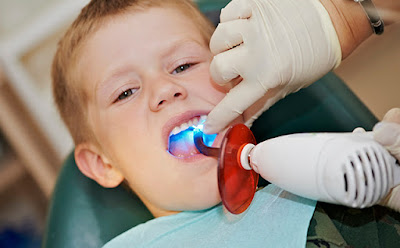"Mom, I bleed a tooth," usually she tells her mother Sandra now and then. "Do not worry, it's nothing," he replies her mother and thinks that maybe would consult a dentist, but then forgets the subject, until their daughter returns to give the warning.
Actually, Sandra tooth but not bleeding gums, something that happens to many people when brushing their teeth. This, maybe without risks seem insignificant may actually generate more problems in the teeth. Especially when time passes and nothing is done to fix it, and even more when it comes to children whose mouth is in full swing.
 It is mistakenly believed that we should not give much importance to the teeth anyway because the children change. However, it is important to have good dental health from an early age so that when permanent or permanent teeth erupt so in a strong and healthy way.
It is mistakenly believed that we should not give much importance to the teeth anyway because the children change. However, it is important to have good dental health from an early age so that when permanent or permanent teeth erupt so in a strong and healthy way.When gums bleed, they swell or are red, may indicate the presence of a disease called gingivitis, which is the first stage of another disease known as periodontal disease. Do not think that children and teenagers are safe, many of them have.Gingivitis arises, both younger and adults, mainly due to poor oral hygiene (bad), but there are other factors that increase the chances of developing it and they are:
• The desnutrition
• Stress
• Have diabetes or generalized infection.
• Smoking, drugs or taking certain medications
• Go through hormonal changes such as puberty and pregnancy.
Periodontal disease occurs when gingivitis progresses because it is not. It usually occurs in adults and can be:
• Aggressive located: mainly affects the first molars and front teeth (those on the front). It is characterized by severe loss of alveolar bone, which is supporting the teeth with very little dental plaque or tartar.
• generalized aggressive: is characterized by inflammation of the gums and heavy accumulations of plaque and tartar. Over time it can cause teeth to loosen.
• Associated with (generalized) systemic diseases such as diabetes and Down syndrome.
The most important signs that indicate you may have periodontal disease are:
• Bleeding gums when brushing, flossing when or at any time.
• Swelling and redness of the gums.
• Gums that recede and reveal the roots of the teeth.
• Constant bad breath that does not go away when brushing.
Have you noticed some of the symptoms? It is best to prevent the situation or try to stop it. How? Maintaining good oral hygiene practices and regularly visiting the dentist (dentist):
• Preferably Brush your teeth after every meal and at least twice a day with fluoride toothpaste.
• Use thread or dental floss at least once a day (if you have dentures or crowns, be careful when flossing, see your dentist proper way to do this).
• Limit sugary foods between meals as well as drinks with caffeine and alcohol.
• Avoid smoking or chewing snuff.
• Visit your dentist regularly (at least once or twice a year).
As you can see, it's not so complicated. You just keep good habits, passing on to your children and teach by example.

